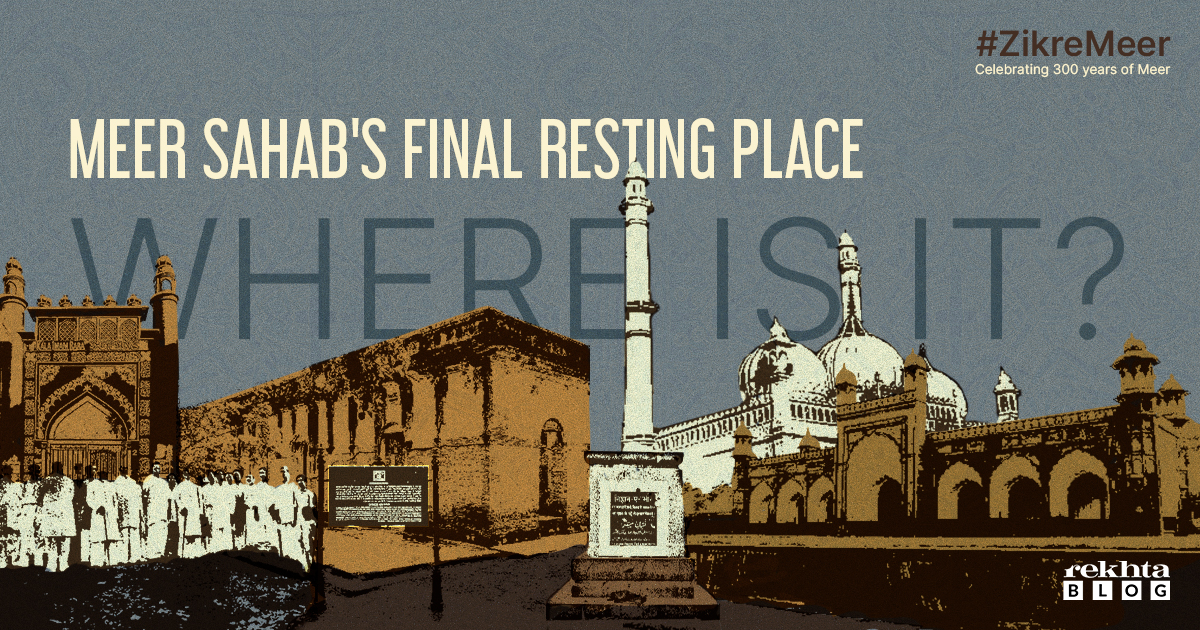
Meer Sahab’s final resting place: Where is it?
2023 marks three hundred years of the legendary poet Meer Taqi Meer. A fresh wave of readers is turning to him, paying tribute to his poetic and linguistic legacy. In this festival of Meer’s life and poetry, a question is being asked more often than any other: Where is Meer’s final resting abode?
The answer is nobody really knows. In fact, most of the dwellings he’s learned to set foot in no longer exist.

Meer was born and raised in Akbarabad (Agra). His father’s Khanqah was near the Eidgah, now a prominent locality in Agra. After the death of his father, Meer Muhammad Ali (popularly known by his title Ali Mutaqqi), Meer had to leave for Delhi in search of occupation. He was offered an honorarium of one rupee per day by Nawab Samsamuddaula. Meer soon returned to Agra to take care of his younger brother. This sum wasn’t adequate but could be used to make ends meet. This stipend ceased when Nawab Samsamuddaula was killed in his battle with Nadir Shah. He lies buried in a small mosque northwest of the Nizamuddin Auliya’s shrine.
Meer Sahab set out for Delhi again and started living with his maternal step-uncle Sirajuddin Ali Khan Aarzoo. A master of the Persian language, poet and lexicographer, Aarzoo was a respected figure in the literary circle. He is said to have nurtured the creative soul in Meer. Meer has praised Aarzoo, referring to him as ‘Peer-o-Murshid Banda’ [=Mentor] in Nikatush-Shuara, but his views about Aarzoo in Zikr-e-Meer contrast this. Meer parted ways with Aarzoo and leased the neighbouring house. These houses were in Wakeelpura, Delhi.
Meer Sahab set out to Lucknow in 1782 at the age of 60. The Nawab of Awadh, Nawab Asifuddaula himself, invited him to join his court. When he arrived, he stayed at the residence of Nawab Salarjung, the maternal uncle of Nawab Asifuddaula. Nawab Salarjung is credited with the construction of the Kaala Imambada.

In Aab-e-Hayat, Aazad writes about an incident where Meer is sitting at the stairs of Tehseen Ki Masjid. Nawab Saadat Ali Khan, with his entourage, passed by. Everyone stood to pay their respects, but Meer kept seated. When the procession ended, Nawab asked Sayyad Insha, accompanying him, about the disgraceful man. Sayyad Insha replied, ‘Your excellency! He’s the same proud beggar whom you’ve often heard mentioned. This is the state of his subsistence – and the nature of his temperament. Today too, he must have had nothing to eat all day.’

Meer’s residence used to be in Mohalla Sathatti or Mohalla Satthi. This locality was on the south bank of the Gomti river. It was also near the Residency. The ancient name of the locality was ‘Sayyadwada’. Mohammad Baqar Shams writes in his acclaimed book Tareekh-e-Lucknow: “In the twilight days of Awadh Shahi rule, Sathatii was a populous and elegant locality. This locality had countless residences and bungalows of the affluent.”
In the wake of the sepoy mutiny of 1857, the British troops destroyed nearby houses and cut down trees in neighbourhoods encompassing the Residency. This locality was presumably razed in this period.

Meer Sahab died on 10 September 1810 in Mohalla Sathatti. He was buried in the graveyard of Akhada Bheem. Situated in Mohalla Akhada Bheem adjoining Mohalla Sathatti, this graveyard had the same fate. Meer Sahab was buried with his wife and elder son, Meer Faiz Ali. Meer Khaleeq, the father of legendary Marsiya poet Meer Anees, was buried in this graveyard.

The actual grave is now covered beneath the dust of time, but many accounts of people visiting Meer Sahab’s grave are known. There was a grave that was attributed to him till the 20th century.

Now the only monument left of this legendary poet is a small memorial named ‘Nishan-e-Meer’. It was erected by efforts of Maqbool Ahmad Lari and lay near the Lucknow City station, where the actual grave is anticipated.

Coincidentally, Meer Sahab wrote about the obliteration of his grave. These couplets now appear to be prophecies, as if he already knew what would be left of his last abode.
turbat-e-‘meer’ par chale tum der
itni muddat mein vaan raha kya khaak
mat turbat-e-‘meer’ ko mitaao
rahne do ghareeb ka nishan to
kya khaak mein milaya ham ko sipahar-e-doon ne
dhoonda nishan-e-turbat pate nahin hamara
NEWSLETTER
Enter your email address to follow this blog and receive notification of new posts.




